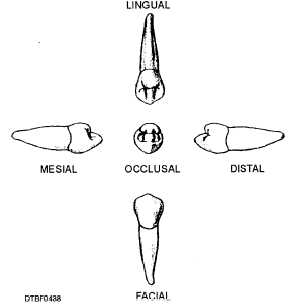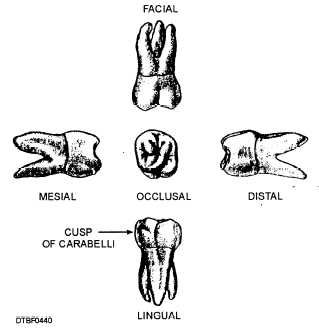Root Surface - The root of the tooth is single, and in a great many instances, the apical region is found to be quite curved.
MAXILLARY FIRST MOLAR
The maxillary first molar (tooth #3 or #14), illustrated in figures 4-40 and 4-41, is the sixth tooth from the midline. The first molars are also known as 6-year molars, because they erupt when a child is about 6 years old
Facial Surface - The facial surface has a facial groove that continues over from the occlusal surface, and runs down to the middle third of the facial surface.
Lingual Surface - In a great many instances, there is a cusp on the lingual surface of the mesiolingual cusp. This is a fifth cusp called the cusp of Carabelli, which is in addition to the four cusps on the occlusal surface.

Figure 4-38. - Surfaces of mandibular first bicuspid.
Occlusal Surface - In all molars the patterns of the occlusal surface (fig. 4-41) are quite different from those of the bicuspids. The cusps are large and prominent, and the broad grinding surfaces are broken up into rugged appearing ridges and well-defined grooves. An oblique ridge, which is not present on the bicuspids, appears here (it also appears on maxillary second and third molars).
Roots - The maxillary first molar has three roots, which are named according to their locations- mesiofacial, distofacial, and lingual (or palatal root). The lingual root is the largest.

Figure 4-39. - Surfaces of mandibular second bicuspid.
Facial Surface - The facial surface has the same facial surface as the first bicuspid.
Lingual Surface - The lingual surface is similar to that of the mandibular first bicuspid, with the exception that there may be two lingual cusps present.
Occlusal Surface - The occlusal surface usually has a total of three well-defined cusps. Viewed from above, the three cusp present a Y-form pattern.

Figure 4-40. - Surfaces of maxillary first molar.
Continue Reading
